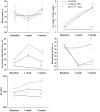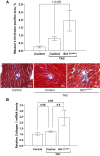Sirtuin 1 ablation in endothelial cells is associated with impaired angiogenesis and diastolic dysfunction
- PMID: 25239805
- PMCID: PMC4269697
- DOI: 10.1152/ajpheart.00281.2014
Sirtuin 1 ablation in endothelial cells is associated with impaired angiogenesis and diastolic dysfunction
Abstract
Discordant myocardial growth and angiogenesis can explain left ventricular (LV) hypertrophy progressing toward heart failure with aging. Sirtuin 1 expression declines with age; therefore we explored the role played by angiogenesis and Sirtuin 1 in the development of cardiomyopathy. We compared the cardiac function of 10- to 15-wk-old (wo), 30-40 wo, and 61-70 wo endothelial Sirtuin 1-deleted (Sirt1(endo-/-)) mice and their corresponding knockout controls (Sirt1(Flox/Flox)). After 30-40 wk, Sirt1(endo-/-) animals exhibited diastolic dysfunction (DD), decreased mRNA expression of Serca2a in the LV, and decreased capillary density compared with control animals despite a similar VEGFa mRNA expression. However, LV fibrosis and hypoxia-inducible factor (HIF)1α expression were not different. The creation of a transverse aortic constriction (TAC) provoked more severe DD and LV fibrosis in Sirt1(endo-/-) compared with control TAC animals. Although the VEGFa mRNA expression was not different and the protein expression of HIF1α was higher in the Sirt1(endo-/-) TAC animals, capillary density remained reduced. In cultured endothelial cells administration of Sirtuin 1 inhibitor decreased mRNA expression of VEGF receptors FLT 1 and FLK 1. Ex vivo capillary sprouting from aortic explants showed impaired angiogenic response to VEGF in the Sirt1(endo-/-) mice. In conclusion, the data demonstrate 1) a defect in angiogenesis preceding development of DD; 2) dispensability of endothelial Sirtuin 1 under unstressed conditions and during normal aging; and 3) impaired angiogenic adaptation and aggravated DD in Sirt1(endo-/-) mice challenged with LV overload.
Keywords: Adriamycin cardiomyopathy; VEGF; angiogenesis; echocardiography; hypoxia; transverse aortic constriction.
Copyright © 2014 the American Physiological Society.
Figures
















Similar articles
-
Rnd3/RhoE Modulates Hypoxia-Inducible Factor 1α/Vascular Endothelial Growth Factor Signaling by Stabilizing Hypoxia-Inducible Factor 1α and Regulates Responsive Cardiac Angiogenesis.Hypertension. 2016 Mar;67(3):597-605. doi: 10.1161/HYPERTENSIONAHA.115.06412. Epub 2016 Jan 18. Hypertension. 2016. PMID: 26781283 Free PMC article.
-
Nrf2 Activation Induced by Sirt1 Ameliorates Acute Lung Injury After Intestinal Ischemia/Reperfusion Through NOX4-Mediated Gene Regulation.Cell Physiol Biochem. 2018;46(2):781-792. doi: 10.1159/000488736. Epub 2018 Mar 29. Cell Physiol Biochem. 2018. PMID: 29621765
-
Overexpression of histone deacetylase SIRT1 exerts an antiangiogenic role in diabetic retinopathy via miR-20a elevation and YAP/HIF1α/VEGFA depletion.Am J Physiol Endocrinol Metab. 2020 Nov 1;319(5):E932-E943. doi: 10.1152/ajpendo.00051.2020. Epub 2020 Aug 10. Am J Physiol Endocrinol Metab. 2020. PMID: 32776826
-
The Multifaceted Role of Endothelial Sirt1 in Vascular Aging: An Update.Cells. 2024 Sep 1;13(17):1469. doi: 10.3390/cells13171469. Cells. 2024. PMID: 39273039 Free PMC article. Review.
-
Endothelial SIRT1 as a Target for the Prevention of Arterial Aging: Promises and Challenges.J Cardiovasc Pharmacol. 2021 Dec 1;78(Suppl 6):S63-S77. doi: 10.1097/FJC.0000000000001154. J Cardiovasc Pharmacol. 2021. PMID: 34840264 Review.
Cited by
-
Capillaries as a Therapeutic Target for Heart Failure.J Atheroscler Thromb. 2022 Jul 1;29(7):971-988. doi: 10.5551/jat.RV17064. Epub 2022 Apr 1. J Atheroscler Thromb. 2022. PMID: 35370224 Free PMC article.
-
Loss of dynamic regulation of G protein-coupled receptor kinase 2 by nitric oxide leads to cardiovascular dysfunction with aging.Am J Physiol Heart Circ Physiol. 2020 May 1;318(5):H1162-H1175. doi: 10.1152/ajpheart.00094.2020. Epub 2020 Mar 27. Am J Physiol Heart Circ Physiol. 2020. PMID: 32216616 Free PMC article.
-
Sirtuins, Cell Senescence, and Vascular Aging.Can J Cardiol. 2016 May;32(5):634-41. doi: 10.1016/j.cjca.2015.11.022. Epub 2015 Dec 8. Can J Cardiol. 2016. PMID: 26948035 Free PMC article. Review.
-
Sirtuins and NAD+ in the Development and Treatment of Metabolic and Cardiovascular Diseases.Circ Res. 2018 Sep 14;123(7):868-885. doi: 10.1161/CIRCRESAHA.118.312498. Circ Res. 2018. PMID: 30355082 Free PMC article. Review.
-
Sirtuin 1 and endothelial glycocalyx.Pflugers Arch. 2020 Aug;472(8):991-1002. doi: 10.1007/s00424-020-02407-z. Epub 2020 Jun 3. Pflugers Arch. 2020. PMID: 32494847 Free PMC article. Review.
References
-
- Arany Z, Foo SY, Ma Y, Ruas JL, Bommi-Reddy A, Girnun G, Cooper M, Laznik D, Chinsomboon J, Rangwala SM, Baek KH, Rosenzweig A, Spiegelman BM. HIF-independent regulation of VEGF and angiogenesis by the transcriptional coactivator PGC-1alpha. Nature 451: 1008–1012, 2008. - PubMed
-
- Bertazzoli C, Bellini O, Magrini U, Tosana MG. Quantitative experimental evaluation of adriamycin cardiotoxicity in the mouse. Cancer Treat Rep 63: 1877–1883, 1979. - PubMed
-
- Brodsky S, Chen J, Lee A, Akassoglou K, Norman J, Goligorsky MS. Plasmin-dependent and -independent effects of plasminogen activators and inhibitor-1 on ex vivo angiogenesis. Am J Physiol Heart Circ Physiol 281: H1784–H1792, 2001. - PubMed
Publication types
MeSH terms
Substances
LinkOut - more resources
Full Text Sources
Other Literature Sources
Molecular Biology Databases

